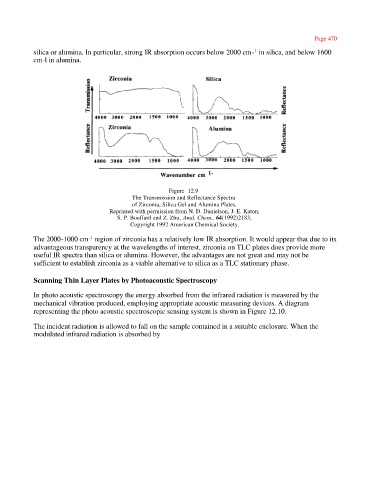Page 485 - Tandem Techniques
P. 485
Page 470
silica or alumina. In particular, strong IR absorption occurs below 2000 cm- in silica, and below 1600
1
cm-l in alumina.
Figure 12.9
The Transmission and Reflectance Spectra
of Zirconia, Silica Gel and Alumina Plates.
Reprinted with permission from N. D. Danielson, J. E. Katon,
S. P. Bouffard and Z. Zhu, Anal. Chem., 64(1992)2183,
Copyright 1992 American Chemical Society.
The 2000-1000 cm region of zirconia has a relatively low IR absorption. It would appear that due to its
-1
advantageous transparency at the wavelengths of interest, zirconia on TLC plates does provide more
useful IR spectra than silica or alumina. However, the advantages are not great and may not be
sufficient to establish zirconia as a viable alternative to silica as a TLC stationary phase.
Scanning Thin Layer Plates by Photoacoustic Spectroscopy
In photo acoustic spectroscopy the energy absorbed from the infrared radiation is measured by the
mechanical vibration produced, employing appropriate acoustic measuring devices. A diagram
representing the photo acoustic spectroscopic sensing system is shown in Figure 12.10.
The incident radiation is allowed to fall on the sample contained in a suitable enclosure. When the
modulated infrared radiation is absorbed by

